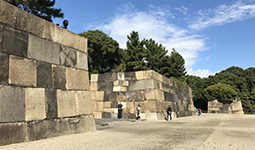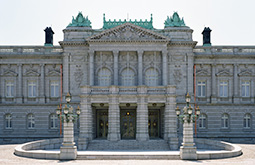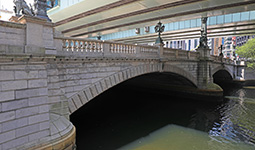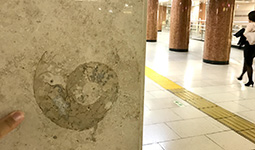INDEX
- English
- 日本語

Nishimoto Shoji, professor at Aichi University - English
- 日本語

Arrowheads made of obsidian occurring naturally in Nagano Prefecture

Ishibutai Tumulus in Nara Prefecture 
Section of the stone walls of Edo Castle constructed from a mix of blackish andesite and whitish granite 
Exterior walls of the State Guest House made of Makabe stone 
Nihonbashi Bridge features four types of stone 
Ammonite fossil on the wall of an underground walkway in Tokyo
- PREVIOUS
- NEXT
October 2021
The Diversity of Japanese Stones

Since ancient times, Japanese people have made extensive use of stones of different kinds as materials for tools, construction, and handicrafts. We spoke with Nishimoto Shoji, a professor at Aichi University, regarding the characteristic features of Japan’s stones.

What types of rocks are found in Japan?
Rocks (commonly referred to as stones) can be divided into igneous rock, sedimentary rock, and metamorphic rock, depending on how they are formed. Igneous rock is formed when hot magma cools and solidifies. Sedimentary rock is formed when sedimentary products such as clasts (sand, clay or fragments of pre-existing rocks) and/or volcanic products such as volcanic ash accumulate. And metamorphic rock is formed when igneous and sedimentary rocks are subjected to heat and pressure.
These rocks are aggregates of various minerals such as quartz, feldspar, and mica, so they are classified according to the type and percentage of minerals they contain. They also differ in terms of characteristics such as color and hardness.
Although Japan’s land area is not so large, it yields a wide variety of naturally occurring stones, reflecting its complex geological features. Each region has its own local stone that has been used as a material for tools, construction, and handicrafts, depending on its particular characteristics.
Tell us about the ways that stones have been used in Japan.
In the earliest times, stones were used to make stone tools. One such stone is obsidian, which is formed when magma cools rapidly. Obsidian is a natural glass that produces sharp-edged cracks when smashed, so it was used to make stone tools such as arrowheads and knives from about 30,000 years ago up to the Yayoi period (10th century BCE to 3rd century CE). Obsidian occurs naturally in many parts of Japan, being a volcanic country, but the area from Wada-toge in Nagano Prefecture to Mt. Yatsugatake is especially famous. Ruins of an “obsidian mine” site have also been discovered, and archaeological digs have revealed that obsidian was widely distributed outside the region.
From the third to the sixth century, kofun (ancient tombs covered with mounds of earth or stone) of various kinds were built in Japan, some of which used stones. One kofun that comes to mind when I hear the word ‘stone’ is the Ishibutai Tumulus in Nara Prefecture. The earth that once covered the Ishibutai Tumulus has now gone, exposing the stone chamber constructed with some 30 massive boulders of tonalite stone (similar to granite), a type of igneous rock distributed in the area. The stones are estimated to weigh around 2,300 tons in total, so it is astonishing to think that they were transported by human effort.

Owing to the abundance of wood resources in Japan, stone buildings were not widespread. It was, however, used for the foundations of buildings such as houses, temples, shrines, and castles. Huge stone walls were also constructed for castles built in the sixteenth and seventeenth centuries. The stone walls of Edo Castle built in Edo (present-day Tokyo), the seat of the Tokugawa shogunate, can still be seen up close around the Imperial Palace. Edo was located in the center of an alluvial plain formed by the accumulation of sediment carried by rivers, so it was not possible to extract large stones suitable for building. Despite this, the stone walls of Edo Castle are constructed of blackish andesite and whitish granite. Andesite was mainly transported by ship from the Manazuru Peninsula in Kanagawa Prefecture and the Izu Peninsula in Shizuoka Prefecture, not far from Edo, while granite was transported by ship from islands in the faraway Seto Inland Sea. Hard granite is a more suitable material for stone walls, but in the days before railroads there was no way to transport large pieces of granite overland from inland areas. Many feudal lords were mobilized by the Tokugawa shogunate for the construction of Edo Castle, and its massive stone walls are a testament to the power of the shogunate.

Why was there an increase in the use of stone to construct buildings in Tokyo during the Meiji period (1868–1912)?
During the Meiji period, Japan actively adopted the social systems, culture, and technology of Western countries in order to modernize the nation. One aspect of this process was the construction of Western-style buildings made of stone. The development of railroads in the Meiji period too enabled different types of stones to be brought to Tokyo from inland areas. This historical background is evident from the stone materials used in modern Western-style architecture from the Meiji period to the early Showa period (1926–1989).
One example is the State Guest House, Akasaka Palace in Minato City, Tokyo. This was constructed in 1909 as the Togu Gosho (Crown Prince’s Palace) and is the only Western-style palace in Japan built in the Neo-Baroque style. Its exterior walls are made of Makabe stone, a type of granite found in Makabe Town, Sakuragawa City, Ibaraki Prefecture. Makabe is one of the three major granite stone production areas, particularly famous for its stone lanterns as a traditional handicraft. The other two are Aji Town in Takamatsu City, Kagawa Prefecture, and Okazaki City, Aichi Prefecture. The exceedingly hard composition of granite makes it difficult to carve finely, but the Makabe stone on the outer walls of the State Guest House features many finely wrought carvings, showing the impressive skill level of the stonemasons of that time. Incidentally, beautiful marble from Europe is used extensively for interior surface finishing.

A variety of stones were also used to construct the Nihonbashi Bridge in Tokyo’s Chuo City, one of the most famous bridges in Japan. The Nihonbashi Bridge was first built by the Tokugawa shogunate in 1603 out of wood, but it burned down several times during the Edo period (1603–late 1860s). The current western-style Nihonbashi Bridge was built in 1911 and makes use of four different types of granite. The piers and foundations are made of Tokuyama stone from Kurokamijima Island (Yamaguchi Prefecture) in the Seto Inland Sea. The parapets are made of Kitagi stone from Kitagijima Island (Okayama Prefecture), also in the Seto Inland Sea. The flanks are made of Makabe stone, and the arches and road surface are made of Inada stone from Ibaraki Prefecture. I think these four different types of stones were chosen for their particular characteristics, such as strength and ease of processing. Later, their use as building materials extended more widely to roads and buildings, underpinning the modernization of Japan.

Another building constructed entirely of Japanese stones, in accordance with the policy of using materials found in Japan as far as possible, is the National Diet Building, completed in 1936. Both the exterior and interior of the building make great use of many different types of Japanese stone, giving it the appearance of a “stone museum.” This comprehensive use of stones to construct the National Diet Building may have encouraged the use of stone materials in Japan.
Tell us about the appeal of natural stone as a building material.
I would say that its appeal is the uneven patterning found in nature that can never be produced artificially. In the rapid development of Tokyo from the Meiji period onward, many different types of stones from Japan and abroad were used. However, since Japan is prone to earthquakes, it was difficult to follow the Western architectural tradition of building only with stone. Instead, concrete became a popular material for the main structure of buildings during the Meiji period, with stone being widely used mainly as a material for interior and exterior decoration. This was partly due to the fact that the use of stone could make a building look Western, but I think it was also due to the decorative appeal of the colors and patterns of stone created by the earth over incredibly long periods of time. Interior and exterior walls made of undressed concrete may be perfectly functional, but when marble is used I think many people feel a sense of luxury.
Tell us what you find interesting when you see stones in the city.
Many people don’t notice it, but cities are full of stones. Stones are used everywhere—the walls of buildings, sidewalks, hotel lobbies, and so on. When I see a stone, work out what type it is, look into how it was formed and why it was used, I appreciate that stones have a significance that goes beyond the field of my own specialty of geology, connecting widely to the history, culture, and economy of a city. It is extremely interesting.
Tokyo in particular is a treasure trove of stones. The area around Tokyo Station is embellished with a variety of stones from all over the world, making it the perfect place to view stones. If you look closely at the stones used for the exterior walls, interior walls, and floors of buildings such as department stores, hotels, and high-rise offices, you can even discover fossils of ammonites and other prehistoric creatures contained in the limestone (commercially “marble”) formed more than 100 million years ago. Pay attention to the stones even in the city that you casually walk around every day, and you are sure to discover something new.

- PREVIOUS
- NEXT

